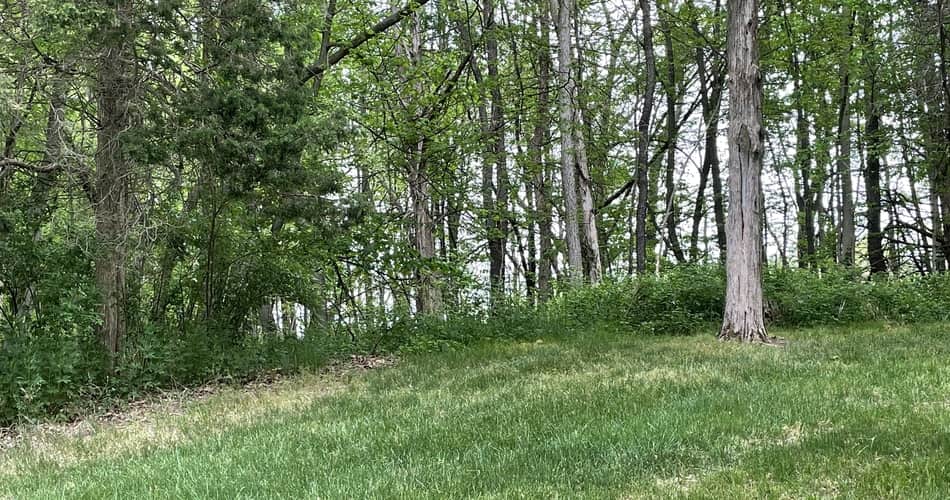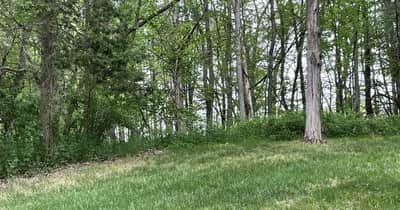From the time zero turn mowers hit the market in 1965 they have not been the best on hills.
The Excel Hustler company brought these mowers to market and since then there have been many other manufacturers that have developed their own zero-turn lawn mowers.
Not one manufacturer can claim it has a mower that is good to operate on hills. All of these companies have tried to develop a mower that operates well on hills, but have failed. There simply isn’t enough weight on the front of the lawn mower.
That along with drive systems that aren’t powerful enough to keep one side of the mower driving correctly when all weight shifts to one side.
Zero-turn mowers are not good on hills. Performance can be improved on slopes not greater than 15 degrees by using a wide turf tire, reducing tire air pressure, avoiding wet conditions, and not overrunning the hydraulic system.

This post may include affiliate links. Purchases made through these links may provide a commission for us, at no extra cost to you. As an Amazon Associate, we earn from qualifying purchases.
Follow all safety instructions provided in your equipment operator’s manual prior to diagnosing, repairing, or operating.Consult a professional if you don’t have the skills, or knowledge or are not in the condition to perform the repair safely.
Tips to Run Your Zero Turn on Slopes
Use the Correct Zero Turn Drive Tires
If you have a slight incline a zero turn isn’t too bad to operate, but it can still slip down the hill with the drive times. Some manufacturers place tires on the rear of the mower with more of a squire edge to them so it holds the hill better.
These tires are often referred to as turf tires, turf trac, or super turf. Lowering the tire pressure in some of these tires can help the mower hold the slope.
I like to run about 10 psi to 12 psi tire pressure in my tires if I have gradual hills to mow and climb.
The wider and softer the tire, the better it is for climbing. More tire surface on the grass is always a good advantage. If the tire has too much air in it the tire can spin and even slide downhill. Even if you try to back up, it can just spin out.
Do Not Over Run the Hydraulics
If you are mowing up a hill and not side to side, one thing you need to remember is not to overrun the hydraulics.
By this I mean don’t try to climb the hills with your zero-turn levers all of the way forward with your pedal right to the floor. Doing this will reduce the life of the pumps.
It’s natural instinct to want to press the levers forward to pick up speed. When you and I drive our vehicles we often increase speed when we see a hill approaching.
With the hydraulic drive systems in our zero turns you need to do the opposite and bring the hydro speed down while the engine is making horsepower.
Let the hydraulics keep up with the engine so the pump creates pressure that will help you better climb your hills.
You should always run the throttle between 3/4 throttle and full throttle to keep the hydraulic oil moving quickly to keep the increased pump pressures.
Not only is it good to run the throttle at this level to build pump pressure, but it is also best for the engine in order to keep the airflow around the engine moving on hot days.
Do Not Operate in Wet Conditions
Wet conditions on hills make operating a zero-turn lawn mower pretty dicey and unsafe. You don’t have much control over your mower on wet grass.
It is not that the mower can’t handle mowing wet grass. The problem is the rubber tires and wet grass don’t create good conditions for traction.
When going downhill with your zero-turn on wet grass will cause you to not be able to control your mower. You build up speed while going downhill and when you attempt to bring your tires to a stop you are not going to be able to steer your zero-turn.
With zero turns, you rely on your wheels to steer the mower and stop your mower. When they are sliding down the hill you are no longer going to be in control of your zero-turn on the way down.
The steeper the hill, the faster you will go down it with no way to stop.
Operate Your Zero Turn on Hills with a 15-Degree Slope or Less
Speaking of steep hills, you better know how steep of you a hill you need to mow and if you are seasoned enough to handle it.
I have heard a lot of stories and seen customer photos of zero turns being rolled over by sliding down hills and into creaks and streams. Some zero turns have been turned upside down in rivers and lakes while mowing a steep bank or hill.
Know your zero-turn, learn how to operate it, and know its limits. The grade of the hills being mowed needs to be a 15-degree slope or less.
If you have hills steeper than 15 degrees you need to find an alternative way to maintain them. You can use a different type of mower. Read more about zero-turn safety here.
Find an Alternative Method to Mow Steep Hills
Look into an alternative mower to cute steep hillsides. If your hillside is not large in size, you can use a weed whip to cut the hill. If your hill is larger you can use a commercial walk-behind mower that will hold a hill better than any rider.
You still need to exercise caution using any type of mower on the hillside. One bad slip on the hill and a very bad injury can happen.
Walk Behind Requirements for Mowing Hills
- Engine
When mowing a hillside you must keep in mind that the engine is powering the zero turn. A small 2-cycle push mower is what a lot of cities and schools use because of its oil aspects. If you keep an engine on its side too long all of the oil will run to one side of the engine.
If oil can’t get to the oil pump you could damage the engine and have to replace it. Even if you are picking up oil on a hill you can still damage the engine over time.
A larger horsepower doesn’t come into play too much because if a bigger engine fails due to lack of oil it just means you will spend more money to fix it.
If you notice your push mower engine smoking every now and then when you are mowing a hill, try a different cutting method such as a diagonal cut. Changing the way you cut might keep the oil in your pump a bit longer. Keep this in mind when mowing steeper inclines.
- Transmission
When it comes to the type of transmission to use on a hill, I don’t think one type is necessarily better than the other. Each type of transmission has its uses, but they each have their faults as well.
The hydraulic drive system is probably the best suited for mowing hills over a belt drive system because of its ground speed and control. With a hydraulic system, you will have a better variety of speeds than you do with a belt drive.
A belt drive has a transmission where the manufacturer designates speed with the gears they select to put in it.
If the manufacturer sets up a second gear to only go 3.5 mph then that is all you’re going to be able to achieve for speed in that gear. If the 4th gear is set at 5.1 mph, this speed may be too fast while the 3rd gear may be too slow.
Both transmission systems run belts, but the hydraulic is easier to get the job done faster. A belt drive unit on a walk-behind, or even tractor, can slip a belt pretty often and you will end up replacing belts a couple of times a year.
I recommend using a hydraulic drive walk-behind if you have the option. It is the better overall choice provided it is driven correctly.
